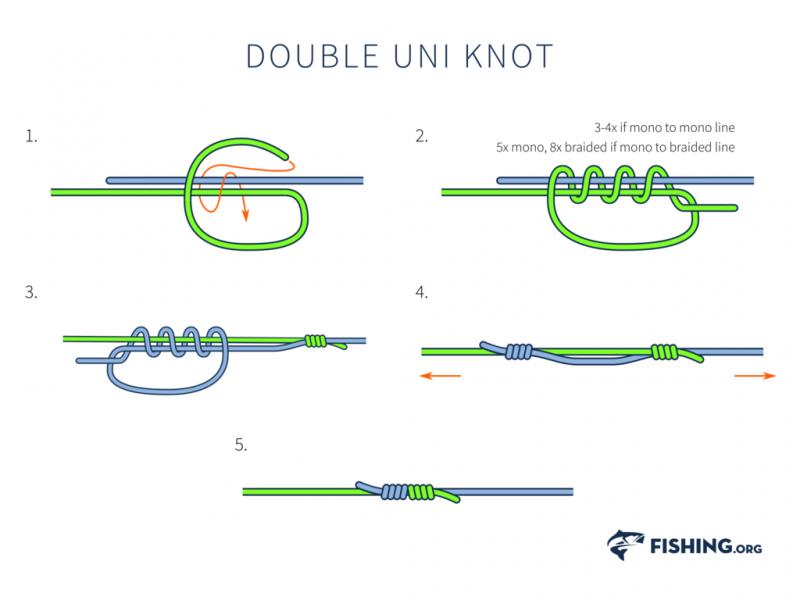
So with that being said lets get into how to make fishing leaders STEP ONE CHOOSE THE RIGHT FISHING LINE FOR LEADERS. Rubber core - elongated weights with a rubber-lined groove.

The first step in tying a fishing leader is to connect your main line to your leader line This is by far the most important aspect of tying a leader line because it will most often be the weakest link in your assembly since the main line is kept light to increase casting performance while the leader is the heavier of the two lines to withstand the sharp teethmouths of many saltwater fish.
How to put a leader on a fishing line. Thread the leader line through the eye of your hook or lure and twist the leader line behind itself to create a loop. Bring the short end of the leader line through that loop and hold the short end of. In this KastKing video about how to tie fishing knots NWT National Walleye Tour Pro Walleye Fishing Champion Dylan Nussbaum shows you how to connect leader.
So with that being said lets get into how to make fishing leaders STEP ONE CHOOSE THE RIGHT FISHING LINE FOR LEADERS. Theres 3 types of fishing leader line. Mono fluorocarbon and wire leaders.
There are reasons to use all 3 but for this tutorial Im using fluorocarbon. Use a line-to-line knot to tie the leader to the main fishing line. Either a double uni or blood knot will do the trick.
Now use whichever knot you want to tie the hook or lure to the leader. This can be solved by attaching your leader line to a swivel before tying it to your main fishing line. A swivel will allow your leader line to freely rotate without twisting your main fishing line.
How To Make A Leader. Making fishing leaders is pretty simple and does not require any fantasy equipment. All it will require is practice.
Most single-line rigs utilize a sturdy monofilament or fluorocarbon leader between the fishing line and the terminal tackle. When used with a bobber at the top of the leader place one or two split shots two or three inches above the hook. Rubber core - elongated weights with a rubber-lined groove.
Insert leader line into groove and twist the rubber to secure. Ofc you can land a pike with mono or fluoro. But the chance that the fish cuts your line will be high.
Also you can catch trouts with mono or titanium leaders but the bite rate can be lower than using just a fluoro line or a braid line flouro leader. We show you how to set up a fishing line. The first step in tying a fishing leader is to connect your main line to your leader line This is by far the most important aspect of tying a leader line because it will most often be the weakest link in your assembly since the main line is kept light to increase casting performance while the leader is the heavier of the two lines to withstand the sharp teethmouths of many saltwater fish.
Monofilament and fluorocarbon are more abrasion-resistant than braid line so the longer your leader is the more abrasion-resistant your line assembly is. When landing fish a monofilament leader is easier to grab than braid so a longer leader makes it easier to bring fish into the boat. It keeps your braid which is easier for fish to see farther away from the lure.
Scenarios where I like to have a longer leader. When Im live bait fishing and sometimes when finesse fishing. In order to attach a leader to braided fishing line for drop shotting its important to pay attention to the diameter of the braid and leader.
Find out how to ensure that the knots will pull together when connecting a leader to braided fishing line with help from a professional bass fisherman in this free video on connecting leaders to braid fishing line. A leader is a length of monofilament line tied to the end of the main line that is on your fishing reel. It can be a metre long if you fish for bream and whiting or it can be 6 or 7 metres long if you gamefish.
It can be lighter than your main line or it can be much heavier than your main line. The other is a hard-wearing leader required to resist abrasion or the teeth of predatory fish such as for a mono mainline to a heavier mono leader. Safe reliable connections for these situations are described here.
Connecting Different Line Types and Diameters. For example connecting a single-strand wire leader to a nylon monofilament line or. The solution is to close the shot tightly and completely down on the line with pincers or pliers.
Then forcibly slide the shot back and forth over the flattened section. As the shot bumps between the flattened spot and the full thickness line it is opened slightly and the inside of the split becomes burnished. Heres a general rule of thumb to help you decide what size line to use for your shock leader.
For every ounce of lead use 10 lbs of shock leader. For example if youre using a 3 oz weight use a 30 lb shock leader. If youre using a 4 oz weight use a 40 lb shock leader.
As far as the length goes use 2-3 rod lengths plus 4-5 rotations. If youre using 20 lb braid as your main fishing line you can toss on a 30-40 lb leader and your line will be a lot harder to break off. The last reason youd want to use a leader is that itll be better for the water if you break off.